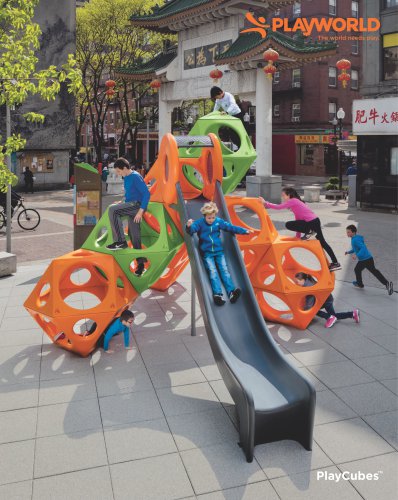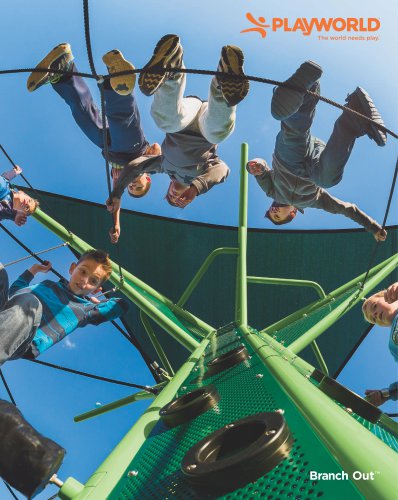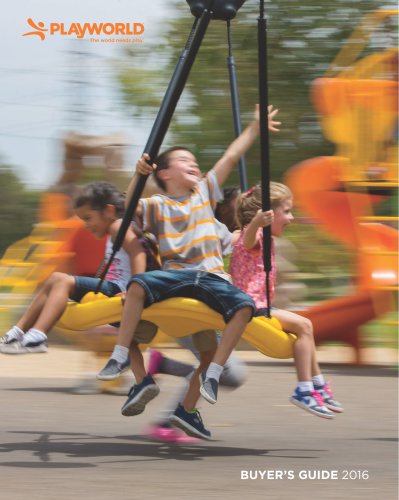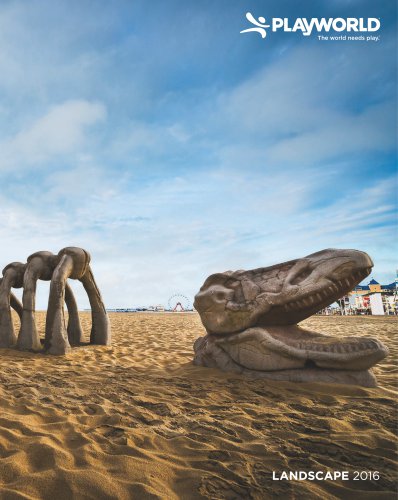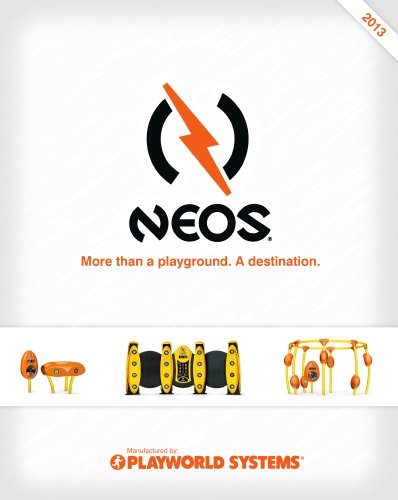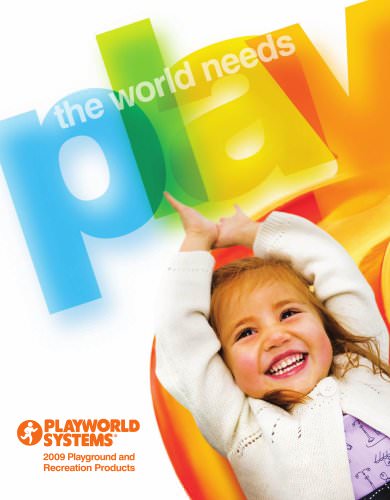Catalog excerpts
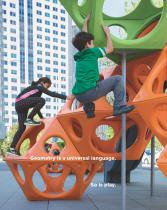
Geometry is a universal language.
Open the catalog to page 3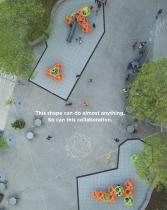
This shape can do almost anything. So can this collaboration.
Open the catalog to page 5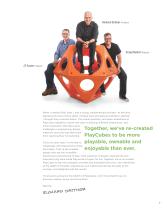
Richard Dattner Architect Craig Mellott Designer When I created PlayCubes, I was a young, inexperienced architect. At the time, playgrounds were mostly slides, monkey bars and seesaws planted in asphalt. I thought they could be better. The simple geometry and open-endedness of PlayCubes helped to inspire new ways of playing, different interactions, and more exploration. But there were challenges in engineering, design, materials, and cost that kept them from reaching their full potential. Together, we’ve re-created PlayCubes to be more playable, ownable and enjoyable than ever. Forty-six...
Open the catalog to page 6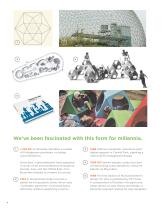
We’ve been fascinated with this form for millennia. 1966 Dattner’s landmark “adventure park” design appears in Central Park, signaling a radical shift in playground design. 1968-69 Dattner designs a play structure of interlocking cuboctahedrons, which he patents as PlayCubes. c.250 BC Archimedes identifies a number of Pythagorean polyhedra, including cuboctahedrons. Since then, cuboctahedrons have appeared in works of art and architecture throughout Europe, Asia, and the Middle East, from Byzantine temples to modern structures. 1969 The first edition of Richard Dattner’s Design for Play is...
Open the catalog to page 7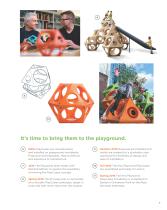
It’s time to bring them to the playground. 6 1970s PlayCubes are manufactured and installed on playgrounds worldwide. Produced with fiberglass, they’re difficult and expensive to manufacture. Summer 2015 Drawings are finalized and molds are created for a stackable cube optimized for flexibility of design and ease of installation. 2014 The Playworld team meets with Richard Dattner to explore the possibility of reviving the PlayCubes concept. Fall 2015 The first Playworld PlayCubes are assembled and ready for action. Spring 2015 The first play test is conducted on a wooden PlayCubes...
Open the catalog to page 8
In today’s virtual world, children need opportunities to connect in real life. To play here, now, together. PlayCubes create that 6
Open the catalog to page 9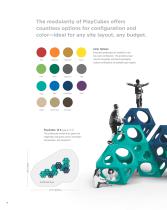
The modularity of PlayCubes offers countless options for configuration and color—ideal for any site layout, any budget. Color Options Cobalt Blue This striking ten-module form ignites the imagination and sparks action, interaction, interpretation, and excitement. ASTM Fall Zone 31'11" (9,75m) PlayCubes predesigns are available in any two-color combination. This provides visual cues for navigation and inspires gameplay. Custom combinations are available upon request
Open the catalog to page 11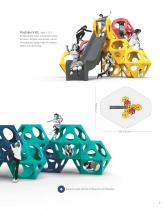
PlayCubes 8.0SL Ages 5–12 Sculptural play meets a playground classic to create a fantastic new favorite—smart, innovative play design ready for climbing, sliding, and discovering. See more views and info at Playworld.com/PlayCubes
Open the catalog to page 12
Seedpod? Submarine? Time machine? With simple, yet fascinating form, PlayCubes can be all the above. PlayCubes 7.0 Ages 5–12 A captivating form and a unique, immersive play experience. This seven-cube design encourages traversing, interaction, and invented games. 27' (8,23m)
Open the catalog to page 13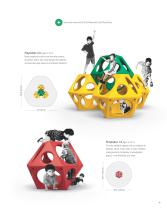
See more views and info at Playworld.com/PlayCubes Bring sculptural artistry and free play almost anywhere with a four-cube design that delivers concentrated play value in an efficient footprint. Turn the smallest spaces into an invitation to imagine, climb, meet, hide, or relax. Refresh a playground or bring play to unexpected places—one PlayCube at a time!
Open the catalog to page 14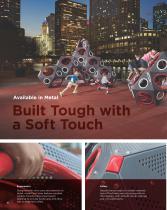
Built Tough with a Soft Touch They’re back with an industrial new twist! PlayCubes are now available in metal—ideal for high-traffic urban or residential playgrounds. Crafted with extra care and attention, these sturdy cubes are just as fun and Ergonomics Designed with extra care and attention to detail, metal PlayCubes feature rounded, climber-friendly rings around each opening to provide better grip and allow kids to enter/exit safely. Despite being made of a harder material, metal PlayCubes are just as play-safe as the originals, with smooth corner castings and concealed bolts.
Open the catalog to page 15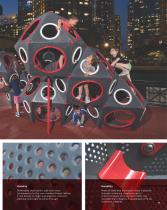
Perforated steel panels add even more transparency to the open-ended shapes, letting in the breeze to help keep playtime cool and allowing more light to shine through. Made of steel and aluminum, these industrialstrength cubes are tough enough to withstand years of heavy foot traffic and maintain their integrity if vandalized or hit by inclement weather.
Open the catalog to page 16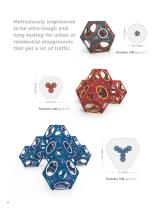
Meticulously engineered to be ultra-tough and long-lasting for urban or residential playgrounds that get a lot of traffic.
Open the catalog to page 17
See more views and info at Playworld.com/PlayCubes
Open the catalog to page 18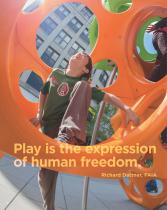
Play is the expression of human freedom. Richard Dattner, FAIA
Open the catalog to page 19
Your authorized Playworld representative is: ^-PLAYWORLD * The world needs play.* 1000 Buffalo Road, Lewisburg, PA 17837-9795 USA Toll-free: 800.233.8404 Phone: +1.570.522.9800 Playworld.com f ^ j|^ gjjj ^E) Q © 2016 Playworld Systems, Inc. All rights reserved.
Open the catalog to page 21
Geometry is a universal language.
Open the catalog to page 22
This shape can do almost anything. So can this collaboration.
Open the catalog to page 24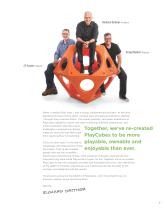
Richard Dattner Architect Craig Mellott Designer When I created PlayCubes, I was a young, inexperienced architect. At the time, playgrounds were mostly slides, monkey bars and seesaws planted in asphalt. I thought they could be better. The simple geometry and open-endedness of PlayCubes helped to inspire new ways of playing, different interactions, and more exploration. But there were challenges in engineering, design, materials, and cost that kept them from reaching their full potential. Together, we’ve re-created PlayCubes to be more playable, ownable and enjoyable than ever. Forty-six...
Open the catalog to page 25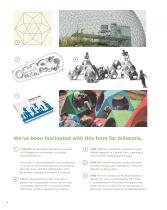
We’ve been fascinated with this form for millennia. 1966 Dattner’s landmark “adventure park” design appears in Central Park, signaling a radical shift in playground design. 1968-69 Dattner designs a play structure of interlocking cuboctahedrons, which he patents as PlayCubes. c.250 BC Archimedes identifies a number of Pythagorean polyhedra, including cuboctahedrons. Since then, cuboctahedrons have appeared in works of art and architecture throughout Europe, Asia, and the Middle East, from Byzantine temples to modern structures. 1969 The first edition of Richard Dattner’s Design for Play is...
Open the catalog to page 26All PLAYWORLD catalogs and technical brochures
-
Playworld
4 Pages
-
Crimson Sky
13 Pages
-
infiNET Brochure
16 Pages
-
New Product Brochure
52 Pages
-
Inclusive Brochure
36 Pages
-
Branch Out®
16 Pages
-
BUYER’S GUIDE 2016
208 Pages
-
SCHOOLS 2016
36 Pages
-
LANDSCAPE 2016
36 Pages
-
PARKS 2016
36 Pages
-
HOUSING 2016
24 Pages
-
Site furnishings
40 Pages
-
LifeTrail®
12 Pages
-
NEOS®
7 Pages
-
PlaySimple®
8 Pages
-
ENERGI®
16 Pages
-
PlayDesigns®
36 Pages
Archived catalogs
-
2009 Playworld Systems Catalog
118 Pages
-
PlayDesigns
76 Pages
-
LifeTrail
7 Pages


